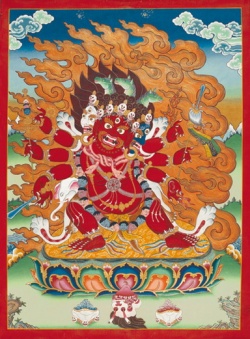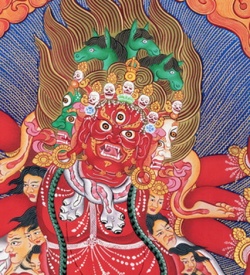Hayagriva is Vishnu as the God of Higher Learning
Hayagreeva, in Hinduism, is considered a minor incarnation of Vishnu; a god mentioned in epic and Puranic literature. He probably originated as a horse god, and later became an avatar associated with wisdom and knowledge. At the request of Brahma, Hayagreeva rescued the Vedas stolen by two demons from the bottom of the primeval ocean. Depicted in human form, he has a head of a horse and eight hands. His attributes are the book (Veda), horse's mane, and rosary plus the attributes of Vishnu.
In Tibetan Buddhism, Hayagreeva is a wrathful manifestation of Avalokiteshvara. There are believed to be 108 forms of Hayagreeva. His special ability is to cure diseases, especially skin diseases even as serious as leprosy, which is said to be caused by the Nagas (malignant water spirits with serpent bodies).It is rumoured that Tibetan horse-dealers worship Hayagreeva because he is believed to frighten away demons by neighing like a horse. When invoked, he is said to announce his coming by neighing, which accounts for the presence of a horse’s head, his distinctive mark, in his head-dress. The horse’s head neighs loudly, and the sound is said to pierce all false appearances of substantiality, revealing the shining reality of freedom.Hayagreeva is the presiding deity of several srivaishnava sects such as Andavan Ashramam, Parakala Mutt and Ahobila Muttum.
Hayagreeva ("Horse-necked" one), characterized by the green horse's head in his hair, is a fierce manifestation of Avalokiteshvara. The horse's neigh cuts through false attachments, revealing the reality of enlightenment.Hayagreeva's anger, directed at the causes of suffering, results from the compassion he feels for his afflicted devotees. The red-capped monks at the top, and Rahula at the lower right, indicate that this painting belongs to the Nyingma tradition. Depicted as part human, part snake, his belly marked with a gaping face, and his body covered with eyes, Rahula is the personification of the eclipse.
The Benefactor, Hayagreeva ("Horse-Necked One")Thangka, painting
Cotton support with opaque mineral pigments in waterbased (collagen) binder 29.75 x 45.0. Hayagreeva (‘horse-neck’) is the fierce assistant of the compassionate Bodhisattva Avalokiteshvara, and their spiritual progenitor, Amitabha, is shown in the flaming hair above the three horse heads. The union with his female partner symbolizes the inseparable nature of wisdom and compassion, a fundamental tenet of Tibetan Buddhism. The vajra sceptre held in Hayagreeva’s principal right hand represents male compassion, and the bell in his left is symbolic of female wisdom. A bow and a skull cup are held in other hands and a flayed human skin is worn over the shoulders and down his back.
Hayagreeva is worshipped in Tibet by those who own horses, because he is believed to frighten away demons by powerfully neighing, which is said to pierce all false appearances, revealing the shining reality of freedom. But, nowhere in the world are horses more central to daily life than in Mongolia, even in the 21st century.
As noted in a article entitled The Last Wild Horses, "...Mongolia remains a horse-based culture and retains its pastoral traditions. Its 2.4 million people are semi-nomadic and support themselves primarily by breeding five domestic species. These are invariably spoken of in a set order: horses, cattle (including yaks), camels, sheep, and goats. The horse, which is used for travel, herding, hunting, and sport, is the most prized."
In the words of a nomadic rancher interviewed by the American Museum of Natural History, "We Mongols respect horse as our companion of night and day. The horse is the source of joy and pride of a Mongolian herder. And we are nothing without our horses."

